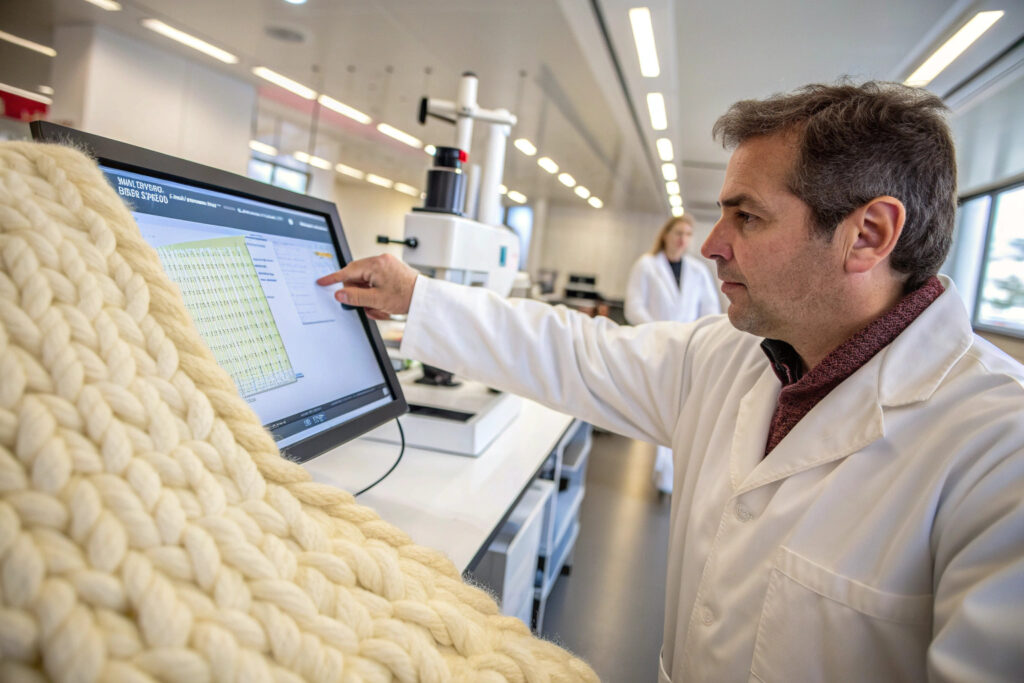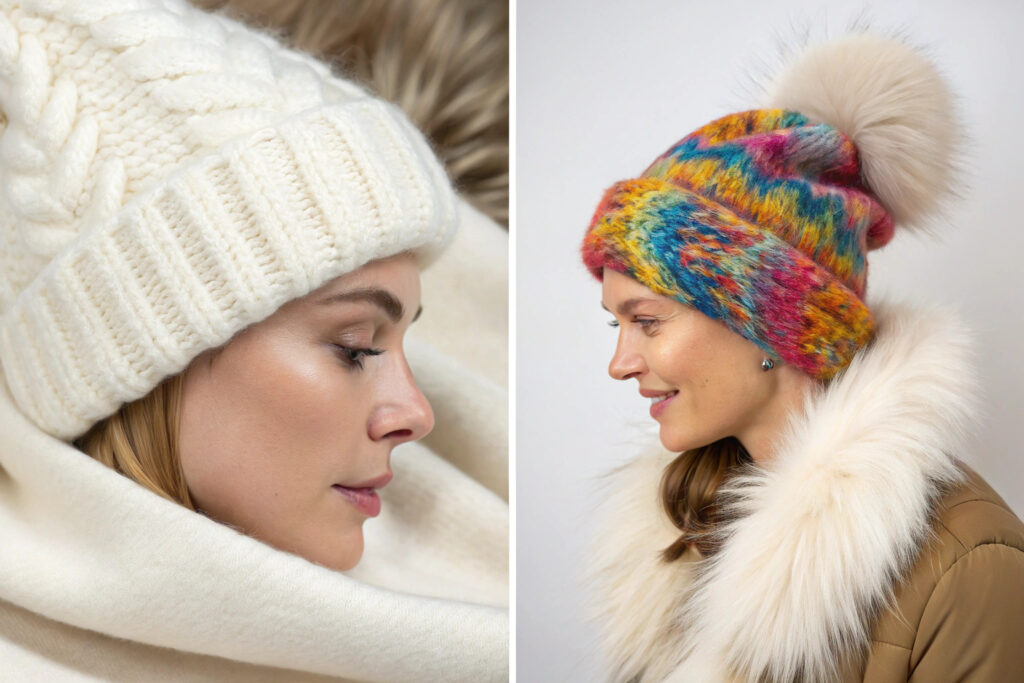Choosing the right material for winter hats can be challenging. You want hats that keep customers warm, look good, and fit their budget. Wool and acrylic each have distinct advantages that suit different market needs and price points.
The choice depends on your target market, price point, and performance requirements. Wool offers superior natural warmth and durability, while acrylic provides excellent affordability and easy care. Understanding these differences helps you select the right material for your specific business needs.
Let's examine the key factors that should guide your decision between wool and acrylic winter hats.
What Are the Core Material Differences?
Understanding the fundamental differences between wool and acrylic is essential for making informed sourcing decisions. Each material has unique properties that affect performance, cost, and customer satisfaction.
The core differences lie in their origin, structure, and inherent characteristics. Wool is a natural fiber from animal coats, while acrylic is a synthetic polymer. These origins dictate their performance in key areas like warmth, moisture management, and durability.

How Does Warmth Performance Compare?
Warmth performance varies significantly between wool and acrylic. Wool's natural crimp creates air pockets that trap heat efficiently, providing superior insulation even when wet. Acrylic relies on its bulk and fiber structure for warmth, performing well in dry conditions but losing effectiveness when damp.
Wool maintains its insulating properties because the natural fiber structure creates microscopic air pockets that retain body heat. Merino wool specifically offers exceptional warmth-to-weight ratio. Acrylic provides good initial warmth but lacks wool's advanced temperature regulation. For extreme cold conditions, wool typically outperforms acrylic, though high-quality acrylic blends can approach wool's warmth at a lower price point.
What About Moisture Management Differences?
Moisture management is where wool demonstrates clear advantages. Wool can absorb up to 30% of its weight in moisture without feeling wet, while acrylic tends to feel damp and clammy when wet. This makes wool more comfortable during physical activity or changing temperatures.
The hydrophobic properties of acrylic mean it doesn't absorb moisture well, leading to potential discomfort. Wool's natural moisture-wicking capabilities pull sweat away from the skin while maintaining thermal regulation. This makes wool ideal for active winter sports where perspiration management is crucial. Acrylic works better for casual wear in drier climates where heavy sweating isn't a concern.
How Do Cost and Value Compare?
Cost considerations extend beyond initial price to include longevity, performance, and perceived value. Your budget constraints and target market positioning will significantly influence which material offers better value for your specific needs.
Wool typically commands higher prices but offers longer lifespan and better performance. Acrylic provides cost-effective solutions for price-sensitive markets or fashion-forward styles that change frequently.

What's the True Price Difference?
The price difference between wool and acrylic hats can be substantial, but understanding the full cost picture requires looking beyond material costs alone. Wool hats typically cost 2-3 times more than comparable acrylic styles when considering raw materials alone.
However, production costs also differ. Wool requires more careful processing and specialized knitting equipment, while acrylic's consistency allows for faster manufacturing. When we factor in minimum order quantities, wool often requires higher initial investment. For bulk orders of 5,000+ pieces, wool hats might cost $8-15 USD per unit, while acrylic versions typically range from $3-7 USD. These costs vary based on design complexity and order volume.
How Does Longevity Affect Overall Value?
Longevity significantly impacts the true value proposition of each material. Wool hats typically last 3-5 times longer than acrylic equivalents when properly cared for, making them a better long-term investment despite higher initial cost.
Wool's natural fiber resilience allows it to maintain shape and appearance through years of use. Acrylic tends to pill and lose its shape more quickly, especially with frequent washing. For sustainable fashion brands, wool's durability aligns with environmental goals by reducing replacement frequency. Acrylic's shorter lifespan may be acceptable for fast-fashion cycles where styles change seasonally.
What Are the Practical Business Considerations?
Beyond material properties, several business factors should influence your decision. These include market positioning, customer expectations, and operational considerations that affect your bottom line and brand reputation.
Your choice should align with your brand identity, target customer preferences, and operational capabilities. Each material supports different business models and market segments.

How Does Material Choice Impact Brand Positioning?
Your material selection directly communicates your brand's values and positioning. Wool typically signals quality, sustainability, and premium positioning, while acrylic suggests accessibility, fashion-forwardness, and value orientation.
Luxury and outdoor performance brands typically prefer wool for its natural heritage and technical benefits. Fast-fashion and value-oriented retailers often choose acrylic for its color versatility and lower price points. Our clients in premium markets find wool supports higher price points and quality perceptions. Meanwhile, acrylic allows emerging brands to enter the market with competitive pricing and frequent style updates.
What Are the Supply Chain Implications?
Supply chain considerations differ significantly between wool and acrylic. Wool availability can be affected by seasonal shearing cycles and geographic factors, while acrylic production offers more consistency and predictability year-round.
Wool sourcing requires relationships with certified suppliers and understanding of wool grading systems. Acrylic production benefits from stable petrochemical industry inputs and consistent quality. We maintain relationships with both wool producers and synthetic fiber manufacturers to ensure reliable supply. Lead times for wool hats can be longer due to raw material processing, while acrylic offers faster turnaround for urgent orders.
How Do Customer Preferences Vary by Market?
Understanding regional and demographic preferences helps tailor your product offerings effectively. Different markets have distinct expectations regarding materials, pricing, and performance characteristics.
Customer preferences are shaped by climate, cultural factors, price sensitivity, and sustainability concerns. These vary significantly across geographic markets and customer segments.

What Do Different Demographics Prefer?
Demographic preferences show clear patterns based on age, income, and lifestyle. Older, affluent consumers often prefer wool for its natural qualities and perceived authenticity. Younger, budget-conscious shoppers typically choose acrylic for its fashion colors and lower price.
Our sales data shows millennial consumers often prioritize ethical production and sustainable materials, favoring wool from certified sources. Generation Z shoppers frequently choose acrylic for its vibrant colors and social media appeal. Families with children often prefer acrylic for its easy care and affordability. Understanding these demographic trends helps target the right material to the right audience.
How Do Regional Climate Differences Affect Choice?
Regional climate conditions significantly influence material preferences. Colder, wetter climates favor wool's superior performance in moisture management and insulation. Drier, moderately cold regions may find acrylic sufficient for most needs.
In Nordic countries and mountainous regions, wool dominates the market due to its performance in extreme conditions. In milder winter climates, acrylic's lighter weight and fashion colors often prevail. We recommend wool for customers in cold climate states like Minnesota and Alaska, while acrylic works well for southern states with milder winters. Understanding these regional variations ensures you stock appropriate products for each market.
Conclusion
Choosing between wool and acrylic winter hats requires balancing multiple factors including performance, cost, customer preferences, and brand positioning. Wool offers superior natural performance and sustainability credentials, while acrylic provides affordability and fashion flexibility.
The right choice depends on your specific business needs, target market, and price points. Many successful brands offer both options to cater to different customer segments and usage occasions.
Need help selecting the perfect material for your winter hat collection? Contact our Business Director Elaine today for personalized recommendations based on your market and requirements. Her email is elaine@fumaoclothing.com. Let's create winter hats that perfectly match your customers' needs and expectations.







